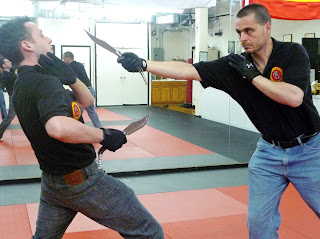 This weekend's training session turned out to be a breakthrough event for me as well as for the session's participants. After three full hours of kenjutsu suburi, we switched gears and picked up tanto knives. The purpose in the change in weapons from Japanese swords to Japanese knives was not, as you might expect, to explore how to apply sword techniques with a shorter blade -- we've already done that extensively in the past. The purpose was to counterbalance the theoretical training with the sword with practical training with the knife!
This weekend's training session turned out to be a breakthrough event for me as well as for the session's participants. After three full hours of kenjutsu suburi, we switched gears and picked up tanto knives. The purpose in the change in weapons from Japanese swords to Japanese knives was not, as you might expect, to explore how to apply sword techniques with a shorter blade -- we've already done that extensively in the past. The purpose was to counterbalance the theoretical training with the sword with practical training with the knife! As a prelude we discussed how fighting arts devolve from artistic systems to near neanderthal applications once they enter the competitive arena. We've all witnessed this. The beautiful, sharp, and crisp movements of the karate dojo fall by the wayside when the exponent enters the ring and faces a liked-trained opponent. The reptile brain takes over, gross motor skills negate the sophisticated movements of the dojo, and the combat ends up looking like a slugfest with two fighters relying on just two or three techniques to repel or defeat the other. What happened to the dozens of other moves they learned in the years of training? Hmmm!
Change the beginning distance in combat from long to extreme close quarters- Change the guard from a traditional one to an upright one, with feet only twelve to 18 inches apart
- Chamber the knife on the lead thigh instead of the lead hip
- Avoid using the off-hand by tucking it behind the waist, inside the belt
- Avoid all counter-cutting or "defanging the snake"; substitute partial or full body evasions as the only means of defense
- Make only committed attacks against the opponent, and only when you have a clear, undefensed line of approach
- Remain relaxed, fighting from a state of mushin, rather than from "active alertness."
As I'd predicted, there were no winners at the end of the session. Each participant "killed" his opponent at some point, only to "be killed" later by the same training partner. That was actually a perfect result since it showed that, regardless of any disparate levels of skill, this kind of realistic fighting levels the playing field.
We conducted an "after action report" (AAR) following the knife-fighting session to explore the findings that participants experienced. Each articulated the different epiphanies he had from fighting at extreme close quarters with a minimal use of traditional tactics. The one discovery they had in common was that all assumptions going in as to who was better were shattered by disregarding the rules, and the ultimate realization that you must fight for your life very differently than you fight for a trophy.
[Note: The above photo is not from the session described.]
